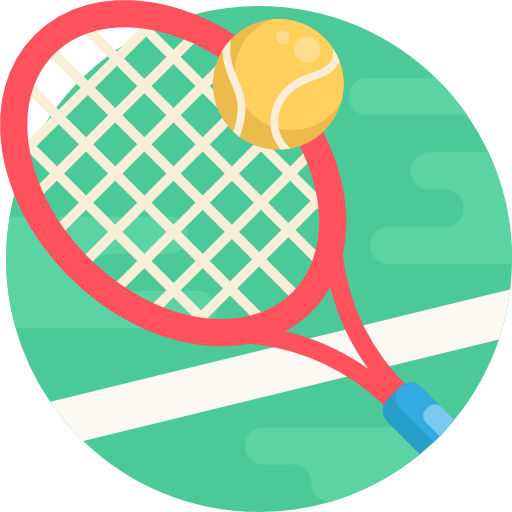When it comes to tennis, the choice of playing surface is critical and can significantly influence the game’s strategy and players’ performance. The three primary types of tennis courts—clay, grass, and hard courts—have distinct characteristics that cater to different styles of play and preferences. Understanding these surfaces’ unique features can help players determine which surface best suits their playing style, physical capabilities, and overall preferences. This article delves into the key differences between clay, grass, and hard courts, alongside the advantages and disadvantages of each, to aid in making an informed choice.
Clay Courts
Clay courts are typically made from crushed brick, shale, or stone, offering a softer and more forgiving surface than other types. This surface has unique properties that impact ball behavior, player movement, and match dynamics.
Characteristics of Clay Courts
- Slow Bounce: The ball tends to slow down upon contact with the court, resulting in a higher bounce. This allows players to have more time to react and prepare for their next shot.
- Slide: The nature of the surface encourages sliding, which can be advantageous for players who can master this technique. Sliding helps maintain balance while adjusting positioning during play.
- Consistency: Clay courts can absorb water, allowing for consistent playing conditions, even during overcast weather.
Advantages of Clay Courts
- Promotes a strategic game, emphasizing patience and endurance over sheer power.
- Reduces the risk of injury due to the surface’s softness, which minimizes impact on joints.
- Favors baseline players and those skilled in constructing points.
Disadvantages of Clay Courts
- Matches can be lengthy due to the slower pace of play, which may not suit all competitors.
- Requires specific footwear (clay shoes), which might add to expenses.
Grass Courts
Grass courts are the traditional surface used in tennis, with the renowned Wimbledon Championships being the prime example. These courts have distinct characteristics, making them a favorite among certain players.
Characteristics of Grass Courts
- Fast Pace: The ball tends to travel faster on grass, resulting in lower bounces. This can lead to shorter rallies and quick points.
- Less Traction: The grassy surface offers less grip, which can impact players’ movement and encourage net play.
- Weather Dependency: Grass courts are susceptible to weather, as they can become slippery when wet, disrupting play.
Advantages of Grass Courts
- Excels for serve-and-volley players so they can take advantage of quick points.
- Offers a unique aesthetic and historical significance in the sport of tennis.
- Shorter matches can lead to exciting, action-packed games.
Disadvantages of Grass Courts
- Lower durability, often requiring maintenance and careful watering practices.
- High risk of injury due to the potential for slipping, particularly in wet conditions.
Hard Courts
Hard courts, made primarily of asphalt or concrete, offer a balanced playing surface that has become the most widely used in professional tennis. They bridge the gap between clay and grass surfaces.
Characteristics of Hard Courts
- Versatile Bounce: Hard courts provide a predictable and consistent bounce, which can suit a variety of playing styles.
- Moderate Speed: While harder than clay, the court speed is still slower than grass, allowing players more time to react compared to grass.
- Durable: Hard courts are long-lasting and can withstand adverse weather conditions better than grass.
Advantages of Hard Courts
- Favors a mixture of playing styles, whether aggressive baseliners or serve-and-volley players.
- Ease of maintenance and lower overall upkeep costs compared to grass courts.
- Often more widely available in recreational facilities, making them more accessible to players of all levels.
Disadvantages of Hard Courts
- Higher impact on joints can be a concern, leading to increased injury risk over time.
- The predictability of play can sometimes lead to less exciting matches compared to grass.
Comparison Table
| Surface Type | Texture | Speed | Player Type | Injury Risk |
|---|---|---|---|---|
| Clay | Soft and gritty | Slow | Baseline players | Low |
| Grass | Natural, smooth | Fast | Serve-and-volley players | High |
| Hard | Hard and smooth | Moderate | All types | Moderate |
Making the Right Choice
The best court surface for you ultimately depends on your playing style, physical condition, and personal preferences:
- If you enjoy longer rallies and strategic play and are focused on mastering your technique, clay courts may be the right choice.
- If you favor a fast, aggressive game that emphasizes quick serves and volleys, grass courts will likely suit you better.
- For a balanced approach that caters to various styles and provides a consistent playing experience, hard courts are ideal.
In conclusion, the decision between clay, grass, and hard courts is personal and should align with your individual preferences and physical attributes. Take into account experimentations and experiences on each type of surface to determine which one enhances your enjoyment and performance in the game of tennis.
